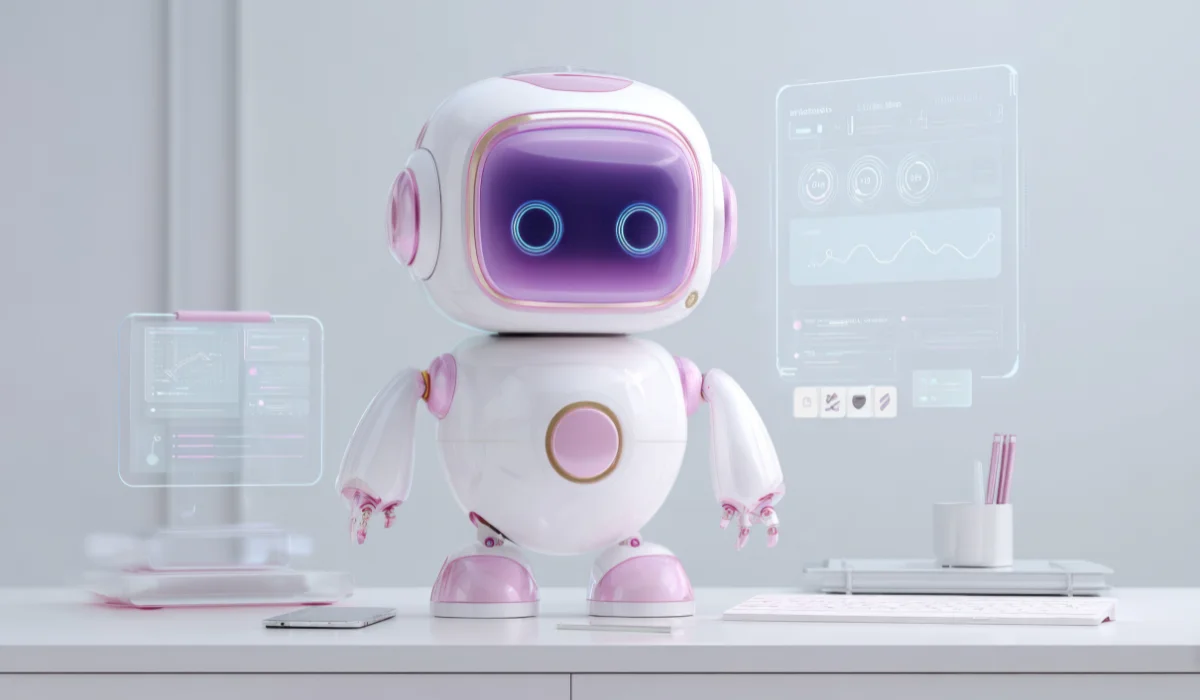Picture if every report, dashboard, and spreadsheet in your company could actually point out what really matters and what actions to take. That’s what AI agents do: they go beyond numbers to uncover the story behind your data.
They don’t just summarize,they spot patterns humans might miss, anticipate outcomes before they happen, and even suggest the next move. For example, an AI agent could warn your supply chain team about an upcoming material shortage, help marketing identify which customers are most likely to churn, or flag areas in finance where costs are quietly creeping up.
Businesses using AI agents for data analysis are making decisions based on insights that are fast, accurate, and actually useful.
In the sections that follow, we’ll unpack what AI agents are, how they operate, and the concrete ways they turn raw data into decisions that move the needle. By the end, you’ll see why they’re becoming an indispensable part of modern business strategy.
What Are AI Agents?

AI agents are not just another analytics tool, they’re more like digital analysts that think, learn, and act on data autonomously. Unlike traditional BI systems that require humans to ask the right questions or build reports, AI agents can proactively explore datasets, detect anomalies, and generate insights on their own.
Think of it this way: instead of telling a system, “Show me last quarter’s sales,” an AI agent can say, “Here’s a pattern in the past three months: sales dipped in this region whenever marketing engagement dropped below X. Here’s a recommendation to address it.” It’s like having an expert analyst who never sleeps, never misses a detail, and can process millions of data points in seconds.
There are different types of AI agents in practice:
- Single-task agents focus on one area like predicting equipment failures or monitoring website traffic.
- Multi-agent systems can collaborate across departments, connecting marketing, sales, operations, and finance.
- Autonomous learning agents continuously improve their predictions as they ingest more data, adapting to changes in business conditions without human intervention.
AI agents turn raw data into actionable intelligence, bridging the gap between information and insight. They don’t just tell you what happened, they help you understand why it happened and what to do next.
How AI Agents Work in Data Analysis: From Raw Numbers to Actionable Insights
At their core, data-driven AI agents follow a simple mission: turn complex, messy data into clear insights that humans can act on. The magic is in how they move from raw data to actionable recommendations, without waiting for someone to run a report.

Here’s a breakdown of their workflow:
Data Collection
AI agents pull data from multiple sources such as internal systems like CRM, ERP, or IoT sensors, and external sources like market trends, social media, or weather data. For example, a retail AI agent might combine inventory levels, sales history, and customer reviews to detect patterns that influence demand.
Data Cleaning and Preprocessing
Raw data is messy: missing values, duplicates, inconsistencies. Data-driven AI agents automatically clean, normalize, and structure data, so models can analyze it effectively. Imagine a manufacturing AI agent noticing discrepancies in machine sensor readings and filtering out false positives before predicting failures.
Analysis and Modeling
Next, AI agents apply algorithms to uncover trends, correlations, and anomalies. They can run regression models to forecast sales, clustering models to segment customers, or anomaly detection to flag unusual transactions. What sets AI agents apart is autonomous reasoning: they connect dots humans might miss, like spotting that declining sales in one region are linked to late shipments elsewhere.
Insight Generation
Once the analysis is done, AI agents summarize findings in human-friendly formats: dashboards, alerts, or even plain-language recommendations. For instance, a financial AI agent could flag a potential cash-flow issue next quarter and suggest adjusting payment schedules, before it becomes a problem.
Continuous Learning
AI agents aren’t static. They learn from each interaction and outcome. The more data they process, the smarter they become, adapting to shifts in customer behavior, market conditions, or operational changes.
Also Read: How AI Agents Are Quietly Transforming Business Analytics
Real-World Applications of AI Agents: Where Data Turns Into Decisions
AI agents are actively shaping decisions in finance, retail, manufacturing, healthcare, and marketing. Here’s how businesses are using them to turn raw data into actionable AI-powered insights:

Finance: Fraud Detection and Risk Management
AI agents can help banks and financial institutions to detect unusual patterns instantly, flagging potential fraud before it escalates. For example, an AI agent might notice a spike in small, rapid transactions from a single account and alert risk teams in real time—something a human would likely miss until after the fact.
Retail & E-commerce: Customer Insights and Inventory Optimization
Retailers use AI agents to understand customer behavior and manage stock efficiently. By analyzing purchase history, website interactions, and social trends, agents can predict demand shifts, prevent stockouts, and suggest personalized marketing campaigns. One online retailer reduced inventory waste by 15% within months after implementing AI-driven demand predictions.
Manufacturing: Predictive Maintenance
Machines break down unexpectedly, causing costly downtime. AI agents monitor sensor data from equipment, identifying patterns that precede failures. Maintenance teams can then schedule repairs proactively, saving both time and money. In one case, a factory cut unscheduled downtime by 20% thanks to AI-driven predictions.
Healthcare: Patient Monitoring and Resource Allocation
Hospitals can also use AI for analyzing patient data easily. AI agents can analyze lab results, vitals, and historical records to flag high-risk patients or suggest resource allocation. For example, an AI agent could predict which patients are most likely to need ICU beds in the next week, helping staff plan ahead.
Marketing & Sales: Campaign Optimization
AI agents analyze leads, customer engagement, and conversion trends to recommend where to focus marketing efforts. A software company used AI agents to prioritize high-potential leads, increasing sales team efficiency and conversion rates simultaneously.
AI agents do more than automate reporting, they identify hidden patterns, suggest actions, and reduce reaction times. Businesses adopting them see measurable gains: faster decisions, reduced costs, improved customer experiences, and more accurate forecasting.
Building and Deploying AI Agents for Data Analysis

Understanding what AI agents do is one thing; knowing how they actually work, and how to implement them, is what separates curiosity from actionable strategy.
1. Core Components of AI Agents
At a high level, an AI agent has four essential components:
- Data Ingestion: Pulls information from ERP or CRM, sensors in manufacturing equipment, or external market data. The goal is to create a unified, continuously updated dataset.
- Processing & Cleaning: Raw data is messy. AI agents automatically remove duplicates, normalize formats, and fill gaps so analysis is accurate.
- Reasoning & Modeling: This is where machine learning comes in. Agents use predictive models, anomaly detection, clustering, or classification algorithms to analyze data. Some even combine multiple models for more nuanced insights.
- Action & Feedback Loop: Insights are presented as recommendations, alerts, or automated actions. The agent also learns from outcomes, adjusting its predictions and improving over time.
2. Training Methods
AI agents rely on different approaches depending on the task:
- Supervised Learning: Uses historical labeled data to predict outcomes, like forecasting sales.
- Unsupervised Learning: Identifies hidden patterns without predefined labels, such as segmenting customers by behavior.
- Reinforcement Learning: Learns optimal actions through trial and error, often applied in resource allocation or process optimization.
3. Deployment Considerations
- Infrastructure: Agents can run on the cloud for scalability, on-premises for sensitive data, or in hybrid setups.
- Integration: The value of AI agents grows when they connect with existing tools such as BI dashboards, CRM systems, or operational software.
- Scalability & Adaptability: Agents should handle growing datasets, adapt to new business rules, and integrate feedback from outcomes.
Implementing AI agents for data analysis is straightforward, but partnering with data consulting services can accelerate adoption and align the technology with your business goals.
What Are the Challenges of Building AI Agents for Data Analysis
AI agents offer significant advantages, but implementing them isn’t without hurdles. Understanding the challenges upfront helps ensure success and avoids costly missteps.
1. Data Quality and Accessibility
AI agents rely on clean, consistent, and complete data. Poor data quality, missing fields, inconsistent formats, or siloed systems, can lead to inaccurate insights. Businesses must invest in data governance, standardization, and integration before expecting meaningful results.
2. Model Transparency and Trust
Decision-makers need to understand how an AI agent arrives at its recommendations. Black-box models can create skepticism and compliance issues. Incorporating explainable AI (XAI) techniques ensures the outputs are interpretable, which is especially important in regulated industries like finance and healthcare.
3. System Integration
AI agents work best when they’re embedded into existing workflows and tools. Poor integration can result in underutilized insights or fragmented adoption. A phased rollout, starting with high-impact areas, helps teams adapt gradually.
4. Security and Compliance
Handling sensitive data requires robust security measures. AI agents must comply with data privacy regulations like GDPR, HIPAA, or industry-specific rules. Proper encryption, access controls, and audit trails are essential.
Also Read: Why Business Should Invest in a Custom AI Agent
Conclusion
AI agents are transforming how businesses turn data into decisions. They go beyond simply collecting or visualizing information, analyzing complex datasets, identifying patterns, and generating actionable AI-powered business insights in real time. Across industries, from retail and finance to manufacturing and healthcare, AI agents help teams act faster, predict outcomes, optimize processes, and reduce errors.
The key to success lies in combining quality data, strategic implementation, and continuous learning. When deployed thoughtfully, AI agents don’t just improve efficiency; they give businesses a competitive edge, enabling smarter decisions, proactive problem-solving, and the ability to seize opportunities that would otherwise remain hidden in the noise of raw data. And with the support of trusted data science consulting services, businesses can leverage the full potential of their data.
FAQs
1.Can ChatGPT or GPT-4 do data analysis?
ChatGPT, including GPT-4, can assist with data analysis but has some limitations. It can interpret trends, summarize data, suggest visualizations, and generate formulas if you provide data in text or structured formats like CSV. However, it doesn’t directly handle large datasets or perform real-time computations like specialized analytics software.
2.Can ChatGPT analyze data from Excel?
Yes, ChatGPT can analyze Excel data indirectly. By pasting spreadsheet content or CSV data into ChatGPT, it can compute summaries, identify patterns, generate insights, and even create formulas. For more advanced use cases or automation, integrating ChatGPT with Python, Excel plugins, or tools like Power Automate is recommended.
3.Can ChatGPT analyze graphs?
Not directly. ChatGPT cannot visually interpret graphs. However, if you provide the underlying data or a textual description of the graph, it can analyze trends, correlations, and patterns, offering insights based on that information.
4.Which AI analytics tools are best?
The best tool depends on your needs. For spreadsheet-based analysis, Excel with Copilot or OpenAI plugins works well. For larger-scale or custom analysis, Python with AI libraries like Pandas or NumPy, combined with ChatGPT API, is effective. Visualization-focused platforms like Tableau or Power BI help explore trends, while specialized AI analytics tools like DataRobot, H2O.ai, or ThoughtSpot provide automated AI-driven insights.
5.Will a data analyst be replaced by ChatGPT?
No, AI cannot fully replace human data analysts. While it can automate repetitive tasks, highlight trends, and speed up reporting, human analysts provide context, domain expertise, and critical thinking, especially when interpreting complex or ambiguous datasets.






